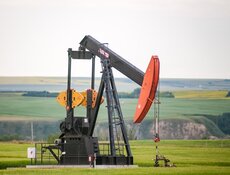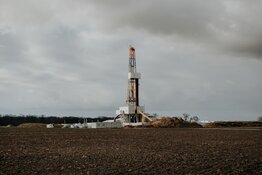Chris Pikul: Well, that's an insightful question. Broadly speaking, we've discovered quite a bit of new gas supplies here in the U.S. I think there's a consensus among industry personnel that $4, sub-$5 and possibly up to $6 gas is not a high enough price to satisfy the market on the longer term. Obviously, I think there's a supply and demand imbalance that could certainly result in lower prices. We need to be cautious of gas prices and how they're going to impact the equities.
On the oil side, we're still growing our demand; China is certainly a big part of that. I think the oil market can still be characterized as, perhaps, supply challenged. That's in sharp contrast to what has happened in the U.S. gas market, which is domestic and not quite as subject to global influences, at least not just yet.
Has that thesis changed? I would have to say, "not really," though the difficulty with the oil side of the equation over the past couple of years has certainly been how the commodity trades in relation to the dollar. It's created quite a bit of volatility. The dramatic change in oil prices from $30 to $150 hasn't really been supported one way or the other by dramatic changes in supply or demand. You're seeing a lot of assets move around as investor preferences change asset classes in relation to perceived risks in currencies, such as the euro as a result of, as you mentioned, the Greek sovereign debt. That can certainly create some swings in oil. So I wouldn't say I am any less bullish on oil, but this sector is giving us opportunities to pick and choose good entry points, and it's been a trader's market. I would say in the longer term that our preference for oil remains unchanged.
Any sort of limitations on deepwater drilling has the potential to be modestly bullish for both gas and oil prices. But, again, the U.S. is really a marginal supplier of oil; so, perhaps less impact on oil, potentially bigger impact on the domestic gas supply.
TER: The report I referred to earlier was published in January. In that report, your 2010 price projections for oil and gas were $70 and $5.50, respectively. Why were you lower than consensus from the get-go?
CP: Well, that's also a very interesting question. I think it is important to establish to investors a reasonable price deck that people should be willing to buy into. If you're going to start buying into very optimistic futures strips, and buying into the $85–$90–$100 oil argument to justify equity investments when prices are between $70 and $80, I think that dramatically increases your risk exposure. I'm really trying to be less predictive of these prices and more interested in determining a reasonable rate range. And certainly in the case of oil, I simply wanted to be conservative; but with gas, I felt that there was some potential weakness that could find its way into that market. We have certainly seen that; I think it bounced up close to $6 at the end of the year, and then we wandered down to $4.
The problem is while we definitely had a weaker gas price in 2009, some of the gas stocks certainly participated in the market rebound; so, you had a decoupling of gas market fundamentals and equity performance. To me, that also increased the relative risk of owning gas companies. And we have certainly seen some more definitive outperformance from the oil names than the gas names this year; so I think the gas stocks are slowly starting to reflect perhaps some changing investor sentiment as to the pace of or timing of any real recovery in natural gas prices.
TER: What is that investor sentiment?
CP: I think people believed fewer operating gas rigs were going to have a big supply impact. I think a lot of people were a little surprised that never seemed to find its way into the domestic production numbers last year. Meanwhile, oil prices are giving a much better margin in the group. I think this notion of a pending gas recovery has sort of kept people involved on the equity side. You're starting to see some of that diminish. The luster is coming off that argument, so you're seeing people gravitate more towards the oily names.
TER: What are your oil and gas projections for 2011?
CP: I'm at $75 and $5.25, respectively, for 2011. Clearly we've seen a little rally in gas prices here for various reasons, but I think that $5.25 could even be a little aggressive. Consensus is still $5.75 for gas; I don't quite know how much faith to place in these consensus numbers, but it still seems like a recovery is baked into some people's expectations of the gas market. I am about as aggressive as I want to be on the gas side.
TER: In another report, you said: "Based on our view that natural gas prices will display much less volatility in 2010. . .We think margin and cost control will become even more important tools for investors to help differentiate between E&P companies." At the same time, you rated Petrohawk Energy Corporation (NYSE:HK) as an outperformer, even though it had the lowest margin of any company on your list. Please explain that decision.
CP: As Petrohawk starts to ramp up production in its Haynesville Shale play, you're going to see company-wide margins improve; and, really, their margins are more a function of pricing right now.
The problem that the market is having with a lot of these gas names—and certainly one that I wrestled with—is that for the first time we're looking at a tremendous resource potential beyond what a company already books as proved. In Petrohawk's case, they're talking 30 TCF; that's a 10x plus multiple to where they are proved—clearly that resource is worth something.
We understand that investors are only willing to pay forward for so much of a resource, but this is sort of a new paradigm for people. In the past, if you had two, three, four, or five times proved in inventory, that was considered quite a multiple of resource to proved. I would expect to see relatively stronger multiples for these gas companies. This inventory is worth something; $4 or perhaps it's not worth that much. People don't think it will be worth that much but it's an important factor. I think that's part of the reason we didn't see these gas stocks necessarily directly track gas prices last year because, while gas prices were wandering lower, well results were continuing to get better and people were proving up more resources. It was creating a little bit of a conflict for investors.
When I say "less volatility," we think increasing supply that would perhaps temper the market, albeit in the $4–$5 range, but rather than relying on gas-price upside, which remember pre-Haynesville, the gas market was still considered supply challenged. So, the prospect for high prices or permanent $7 plus sort of pricing was part of investor psychology, and pricing upside does create a lot of the upward justification for equity investment in some of these companies.
In a $4–$5 price environment, investors are going to have to shift their focus when considering investing in a gas company; certainly operating margins are going to be a more important component. In an area like the Haynesville, you have very productive wells and generally low lifting costs. As more and more of Petrohawk's production shifts into Haynesville production, we should see company-wide margins improve. To their credit, they had among the lowest lifting costs in the group; so, you're seeing their overall net margins compressed more by pricing than by operating efficiency.
TER: Earlier you said that investors will have a de facto preference for some of the more oily names. What are some of the more "oily" names you like?
CP: Here at Morgan Keegan one of our top picks for the year was Whiting Petroleum Corporation (NYSE:WLL), a company that has a nice footprint in the Bakken Shale play. Let me just say there's much less oil focus with smaller cap and E&P companies, so the sandbox is a little smaller when it comes to identifying oil companies. A little harder to find but within my specific coverage group right now I have Berry Petroleum Company (NYSE:BRY), Whiting, Concho Resources Inc. (NYSE:CXO) was a recent addition, Continental Resources Inc. (NYSE:CLR), and certainly Kodiak Oil and Gas Corp. (AMEX:KOG) in the smaller caps.
These companies certainly stand out. And as the preference for oil seems to have increased, we're certainly seeing outperformance in many of these companies. But Whiting is one that I like for the footprint in the Bakken, and it has an interesting exploration program where the company's had some pretty good success on a fringe area of the Bakken it's calling Lewis & Clark. It has a very big footprint there of 200,000 acres; that's one that can be a catalyst for the shares. Whiting's evaluation didn't typically reflect the high multiples that people are willing to pay for high-margin oily growth from peers, like Continental, which has a much bigger acreage footprint—over 600,000 acres in the Bakken.
TER: What's your target price on Whiting?
CP: Well, officially, we don't have target prices at Morgan Keegan so I'll probably have to defer that question; but we have fair value ranges that tend to change based on fluctuations.
TER: Tell us about the other companies you mentioned, perhaps Berry.
CP: Berry is a heavy oil producer and it's kind of in a unique position. The company benefits from low gas prices to generate steam for their thermal recovery operations in California. So they're benefiting on both sides—lower gas prices and higher oil. We think that stock trades relatively cheaply, less than what we think their proved reserves are worth (in other words, what they've already discovered). The stock seems to have found a range below $35 that we peg as what their reserves are worth, granted that is forecasting another year of reserve growth. Berry should appeal to a lot of value investors, even though it's still growing at a decent, respectable rate of about 10%.
TER: You mentioned a couple of others—Concho and Kodiak; how about those?
CP: Concho operates in the Permian Basin, which typically has been viewed over the past several years as a tired, mature basin. But this is a place where oil is still being produced. Concho has been a consolidator; it bought some decent acquisitions late last year. This is a company that is primarily oily and has a very good growth profile. For investors looking for a lot of oily exposure, this has been a popular name. You're seeing a fairly robust multiple there; but if oil stays at these levels or reaches the $80–$85 or $90 consensus number, there's certainly a lot of upside to the assets. That's sort of a simple story, but people are looking to the Permian, people wanting to acquire assets. This is an area that can certainly be ripe for additional growth through M&A activity going forward.
TER: Is new technology basically making resources available in older basins that were not available previously?
CP: Oh, very much so, and you really saw it on the gas side. The technology was developed for the Barnett Shale in terms of horizontal drilling. As the industry found better ways to expose the drill bit to more rock and to more efficiently stimulate that rock, we transitioned into the overpressure Haynesville. And now the Marcellus and the Granite Wash—this new drilling completion technology—certainly opened a tremendous wealth of gas resources, which is still being digested by politicians and investors alike. There are some arguments that certainly gas should feature a more prominent role in the nation's energy future, though that hasn't gained a lot of traction until just recently.
And, generally speaking, though the process and the technologies are a little different, what we're seeing in the Bakken in terms of 10,000-ft. horizontal laterals, is 18 stages of completion—that same sort of technology is helping to open up oily plays as well.
TER: Earlier you mentioned that gas-company stocks had experienced dramatic rises last year even though the gas price did not experience much of a rise at all. What's the outlook for gas companies for the remainder of 2010?
CP: I think part of the reason for the outperformance last year was because we were coming off a very distressed equity market; in some cases, stocks traded quite low for a brief period of time. On a calendar-year basis, you certainly saw gas equities participate in the overall energy and broader market recovery; although looking forward, I think gas prices could very well be between $4 and $5 this year. I think that's probably incrementally negative to what investor perception may be. Most companies have fairly attractive hedges still in place that are supporting cash flows. The problem some of these companies are facing is that these higher-priced hedges put in place a year or two ago—call it $6.50 up to $7—roll off in 2011, even though they're growing production sometimes in the neighborhood of 30%–40%.
Cash flow is growing much less because the realized pricing is going to be down in 2011. So for companies still bootstrapping a new shale program, they're outspending cash flow. You need to be really focused on gas companies with the best-quality assets and strong balance sheets to ensure they can develop these assets in this kind of price environment. You really have to pick and choose. I think it gets a little harder to do that on the gas side. There are still quality companies out there with very attractive, long-term potential.
TER: Speaking of "long-term potential," which E&P gas names are you following that have attractive, long-term potential?
CP: One of the easiest cases you can make is for Range Resources Corporation (NYSE:RRC). We've seen a lot of joint ventures in the Marcellus, where they're one of the biggest acreage holders—deals between $10,000 and $14,000 per acre just to get into these plays. There have certainly been some transactions for less, in the $5,000–6,000 range, but we see Range as the first mover in this play with ramping production. They're over 100 MMcfe a day now; they're in a liquids-rich portion of the play, which increased margins. Marcellus, for the time being, gets a small premium in pricing in the Northeast vs. Henry Hub. Marcellus has a lot of attractive features, so that's drawing a lot of investors from other E&P companies.
If you apply some of those acreage metrics to Range—call it 900,000 in the Marcellus Fairway—you can get into some pretty dramatically higher equity prices. So, if you're going to believe in something north of $10,000 an acre, you can get to an $80 stock pretty easily. Right now, I believe the stock is probably more reflective of a $5,000–6,000 an acre implied value on their Marcellus stuff. And that doesn't really apply much value to any of the other assets the company has in the Barnett outside of what they've already proven. I think that's one gas name where even recent transactions in a relatively weak fundamental environment suggest the long-term outlook will be fairly bright.
TER: What about some other names?
CP: Well, Petrohawk, like I said, they have a very attractive Eagle Ford Shale position, which has a liquidy component. It seems to be trendy to be liquidy and, make no mistake, Petrohawk is certainly very levered to gas prices at this point—but from an asset perspective and from where they trade vs. what we think their proved NAV is worth, which again I am pegging at year-end 2010 at a $5.70 benchmark price, somewhere in the neighborhood of $15. They're trading at a premium to what they've already proven, but with such large resource potential behind what they've already proven, I certainly think that a healthy premium to what they've already proved is in order despite a gas market that has some pricing risk over the next 6–12 months.
Again, asset quality and the balance sheet are very important considerations in any gas investment in this environment. I think a company with a little bit of a different twist on the gas component is Bill Barrett Corporation (NYSE:BBG), a company I recently upgraded. Traditionally, the Rocky Mountains has been a region compromised by natural gas prices due to pipeline infrastructure issues that have resulted in sometimes dramatically lower gas vs. national prices. With the pullback in drilling, especially in the Rockies, Bill Barrett actually has very strong margins and good liquid production from their Piceance play. And with that pricing disadvantage gone, certainly for the time being and perhaps over the longer term, I think that makes their assets more attractive. They traded at really a rock-bottom valuation compared to the group. They have some legislative issues that may be resolved this summer, which will allow them to reaccelerate drilling in one of their core properties. That could result in some very strong production growth in 2011. So, that's a much cheaper, much more palatable way to play the gas market. They certainly don't have the kind of resource potential that companies like Range and Petrohawk represent, but I certainly don't think you're paying for it in this environment.
TER: Are there any other even smaller names that you like?
CP: Kodiak, as I mentioned before, has about 30,000 net acres in the Bakken. It's a little bit of a smaller player but one that will be growing production rapidly. They, potentially, could double production this year. They also have some potential in the Three Forks/Sanish area, which various companies are in various stages of proving up. Both of these formations could be productive areas of the Bakken. This is very much a growth vehicle, but one that is more palatable to small-cap people.
TER: Any thoughts you'd like to leave our readers with?
CP: This is an exciting group to follow. A lot of factors can influence the equity prices here; and with the problems in the Gulf going on, there are a lot of different ways to analyze this group. Right now, the volatile swings give you some opportunities to periodically dip in and own some very good-quality companies. We're seeing anywhere from 10%–20% moves in a week or two. It hurts to be on the wrong side of these; but, if you're timing your way into quality companies, I think you could really look back at this as a quality time to be adding select companies. It's challenging, but it gives you a chance to win the game.
Chris Pikul, CFA, joined the firm in 2007 as a senior equity research analyst covering the energy exploration and production sector. Pikul is based in Denver, Colo. Prior to joining Morgan Keegan, Pikul was an analyst with A.G. Edwards for seven years covering small and mid-cap energy stocks. He also worked for four years at Invesco Funds. A chartered financial analyst, Pikul received his bachelor's and master's degrees in finance from the University of Colorado.
Want to read more exclusive Energy Report interviews like this? Sign up for our free e-newsletter, and you'll learn when new articles have been published. To see a list of recent interviews with industry analysts and commentators, visit our Expert Insights page.
DISCLOSURE:
1) Brian Sylvester of The Energy Report conducted this interview. He personally and/or his family own the following companies mentioned in this interview: None.
2) The following companies mentioned in the interview are sponsors of The Energy Report: None.
3) Chris Pikul: I personally and/or my family own shares of the following companies mentioned in this interview: None. I personally and/or my family am paid by the following companies mentioned in this interview: None. *See Morgan Keegan disclosure.
*Morgan Keegan Disclosure:
Morgan Keegan & Co., Inc. has managed or co-managed a public offering of equity securities for these companies in the past 12 months: BRY, CXPO, EXXI and HK.
Morgan Keegan & Co., Inc. has received compensation for investment banking services from these companies in the past 12 months: BRY, BPZ, CXPO, EXXI and HK.
Morgan Keegan & Co., Inc. expects to receive or intends to seek compensation for investment banking services from these companies in the next 3 months: BRY, BPZ, EXXI, HK and XTO.









































